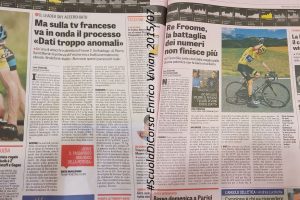
Non ha urgenze di cronaca né smanie social, quindi Michele Ferrari si è preso una settimana dal termine del Tour de France prima di pubblicare i suoi numeri, due mesi dopo quelli del Giro d’Italia, sempre in inglese potabile.
Chris Froome deservedly won an edition of the TdF that offered a lower competitive level that expected and that was, as too often happens nowadays, scarred by the usual gratuitous accusations of doping by the losers (some French media).
With not much happening in the dreaded stage on the cobblestones, it was thanks to the roundabouts, the rain and the winds of Zealand that we saw the first selection already in the second stage, with Quintana and Nibali both paying 1’30”, a delay that for the Colombian eventually would be crucial.
On the Pyrenees, in the first mountain stage with arrival in La Pierre Saint Martin, the infernal pace imposed by Team Sky, with the complicity of a torrid heat, buried all of Froome’s rivals except for Quintana who, in addition to the minute of delay, also had to suffer the humiliation of being overtaken on the line by Porte, even though the latter had worked so hard for his captain on the preceding ramps. In particular, a disappointing Nibali had to give in over six minutes, which in addition to the delay accumulated in the first stages, forced an early farewell to the podium in Paris.
Froome rode the climb (15.7km at 7.4%) in 41’42”, a VAM = 1670m/h, equal to 6.18W/kg = 417Watt, according to my measurements. This immediately spurred a deluge of delusional estimations/evaluations of more than 7W/kg and subsequent accusations of doping (blood, technological and other), forcing Team Sky to reveal the data of the athlete: “414w average, average heart rate 158bpm, 174bpm HR max, weight 67.5kg. At the moment of the attack 556W for 25″ with a peak of about 929W, then in the next 4 min 449W average, with a VAM = 1777m/h”. Great numbers, but perfectly in line with those expressed in the TdF’s of the recent past by the best climbers, including Armstrong. It was Froome’s rivals who ended up performing much worse than expected, especially Nibali and Contador, two of the “magnificent four” at the start.
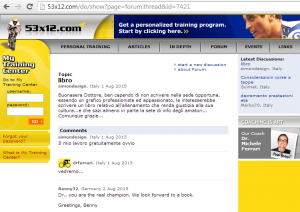 Plateau de Beille (15.9km at 7.9%) was done by the group of the best riders in 45’30″(VAM = 1656m/h = 5.93W/kg); Armstrong in 2002 climbed it in 45’55” and in 2004, together with Basso, in 45’31”. The short climb to Mende (3km to 10%) was performed in 9’38”: 1907m/h = 6.35W/kg, far from the record of Pantani – Indurain – Riis of 9’03” in 1995.
Plateau de Beille (15.9km at 7.9%) was done by the group of the best riders in 45’30″(VAM = 1656m/h = 5.93W/kg); Armstrong in 2002 climbed it in 45’55” and in 2004, together with Basso, in 45’31”. The short climb to Mende (3km to 10%) was performed in 9’38”: 1907m/h = 6.35W/kg, far from the record of Pantani – Indurain – Riis of 9’03” in 1995.
On the Alps, in the stage towards La Toussuire (18km at 6.1%) the race changed its face: the absolute control of Froome allowed for a nice long-ranged attack from Nibali, 60km of solitary escape resulting in a big stage victory and the surmounting of a few GC positions; Quintana finally attacked and got 30″ on the British: 44′ was the time of Nairo (1500m/h = 5.75W/kg), 45’30” for Nibali.
On the Alpe d’ Huez, the race confirmed that Froome was in sharp decline, but it was too late and the English saved himself also thanks to the great work of Porte and Poels: 39’10” was Quintana’s time, 1710m/h = 6.11W/kg, which is very respectable considering the earlier attack on the Croix de Fer and the fatigue accumulated over 20 stages of the TdF. Froome gave in 1’30”, repeating his time of 2013 and confirming he does not like this mythical climb.
At the finish in Paris, the two rivals would be separated by just over a minute, much to the regret of Team Movistar, despite the third place of a great Valverde. Froome’s performances, who was heavily insulted in the last stages by overeager fans probably excited and incited by the many allegations in the French press, are in line with those of the TdF of the past 15 years.
His disproportionate body, that already in 2013 I defined as “alien”, his ungainly position on the bike, his accelerations at cadences never seen before make Chris a cyclist “different” from the classic stereotypes of the European tradition, such as Nibali, Quintana, Valverde and Contador himself. Different and therefore suspect.
Nibali and Contador surely performed below their potential. In my opinion Vincenzo was wrong in repeating the same preparation as last year: his coach, the competent Paolo Slongo, is an excellent copyist, but not (yet) a real artist. Alberto probably partially paid for the efforts of the Giro, but he has been pedaling with much lower cadences and slower than the past, perhaps because of a change in training methods.

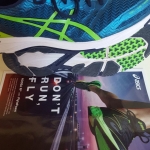

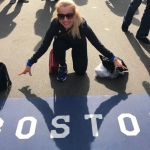
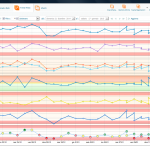
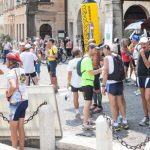

Leave A Comment